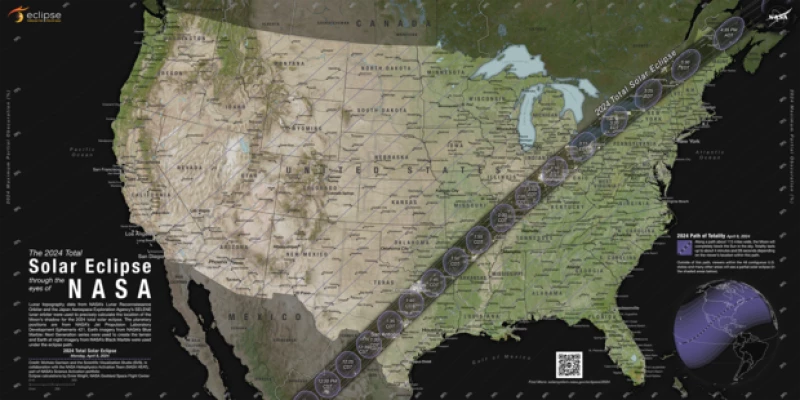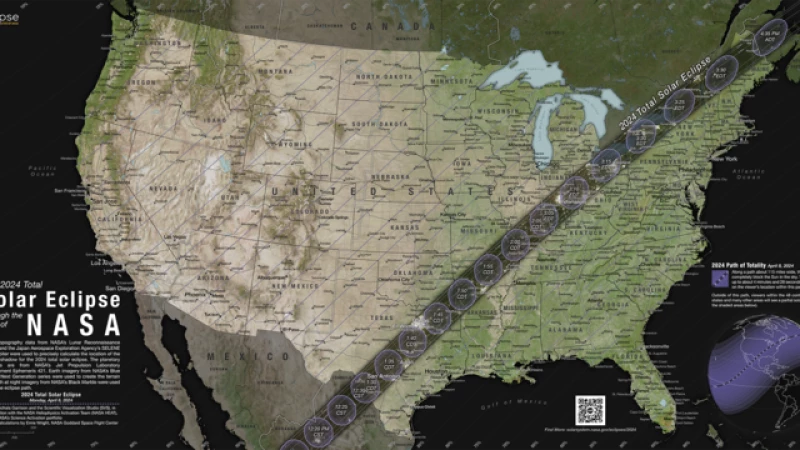A total solar eclipse will sweep across North America on April 8, 2024, passing through parts of 15 U.S. states within the path of totality. Detailed maps are available to guide astronomy enthusiasts on when and where to witness this spectacular event.
The total eclipse is set to make its debut along Mexico's Pacific Coast at approximately 11:07 a.m. PDT, then journey across a wide stretch of the U.S., from Texas to Maine, before heading into Canada.
According to NASA, around 31.6 million individuals reside in the path of totality, where the moon will completely obscure the sun. The path's width will vary between 108 and 122 miles, with an additional 150 million people living within 200 miles of the totality path.
Solar eclipse path of totality map for 2024
The total solar eclipse will commence over the Pacific Ocean, with the initial location in continental North America to witness totality being Mexico's Pacific Coast at 11:07 a.m. PDT on April 8, as per NASA. The eclipse's trajectory will then proceed into Texas, traversing over a dozen states before reaching Canada in southern Ontario. The eclipse will bid farewell to continental North America around 5:16 p.m. NDT from Newfoundland, Canada.
The states included in the path of totality are:
- Texas
- Oklahoma
- Arkansas
- Missouri
- Illinois
- Kentucky
- Indiana
- Ohio
- Pennsylvania
- New York
- Vermont
- New Hampshire
- Maine
Small parts of Tennessee and Michigan will also experience the total solar eclipse.
Several major cities across the U.S. are included in the eclipse's path of totality, while many others will see a partial eclipse. Here are some of the best major cities for eclipse viewing — if the weather cooperates:
- San Antonio, Texas (partially under the path)
- Austin, Texas
- Waco, Texas
- Dallas, Texas
- Little Rock, Arkansas
- Indianapolis, Indiana
- Dayton, Ohio
- Cleveland, Ohio
- Buffalo, New York
- Rochester, New York
- Syracuse, New York
- Burlington, Vermont
Map of when the solar eclipse will reach totality across the path
The eclipse will begin in the U.S. on the afternoon of April 8. NASA shared times for several cities in the path of totality across the U.S. You can also check your ZIP code on NASA's map to see when the eclipse will reach you if you're on, or near, the path of totality.

How much of the eclipse will you see if you live outside of the totality path?
While the April 8 eclipse will cover a wide swath of the U.S., many won't see anything. Outside the path of totality, observers may spot a partial eclipse, where the moon covers most, but not all, of the sun, according to NASA.
NASA has provided a way for viewers to input their ZIP code and determine how much of the sun will be covered in their specific location.
Which location will experience the longest totality during the solar eclipse?
Residents near Torreón, Mexico, will have the opportunity to witness totality for the longest duration. The total solar eclipse in Torreón will last for 4 minutes and 28 seconds, as confirmed by NASA.
Most areas along the central path of totality will have a duration of totality ranging between 3.5 and 4 minutes. Kerrville, Texas, for example, will experience a totality duration of 4 minutes and 24 seconds.
Where will the path of totality be for the 2044 solar eclipse?
Following the eclipse on April 8, the next total solar eclipse visible from the contiguous U.S. is scheduled for August 23, 2044.
Compared to the upcoming eclipse, astronomy enthusiasts in the U.S. will have fewer opportunities to witness the 2044 eclipse. Although NASA has not released maps for the 2044 event yet, The Planetary Society states that the path of totality will only cross three states.
The 2024 eclipse is expected to begin in Greenland, pass over Canada, and conclude as the sun sets in Montana, North Dakota, and South Dakota, as outlined by the Planetary Society.







